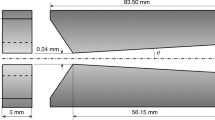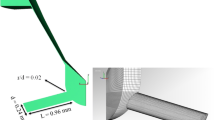Abstract
This work describes numerical simulations applied for the investigation of vapor injection into subcooled flow in a capillary jet loop (CJL) system. The improvement of the injector (or ejector) design is discussed here by examining several parameters influencing its performance. Consequently, this paper covers the influence of the entrainment ratio γ (the ratio of the mass flow rate of the low-pressure secondary flow to the mass flow rate of the high-pressure primary flow), the characteristics of the working fluid, and the geometry on the pressure rise through the mixing region, the criterion chosen here to measure the injector efficiency. Considering that full condensation is expected to occur, part of the simulation will also cover the numerical aspects related to phase change to establish the most appropriate choices for obtaining a reliable solution for full condensation cases. Here, condensation is studied for two different injector designs: one with a vapor nozzle inclined to the direction of subcooled flow and the other with an inline orientation with respect to the secondary flow. From computational fluid dynamics (CFD) simulations performed using the commercial software Ansys Fluent (versions 19.4 and 2023R1), a parametric study indicated that increasing the injection angle had a negative impact on the pressure increase. The same negative impact was observed for γ. Regarding the working fluid, the use of methanol and acetone appeared to increase the pressure rise in the vapor injection region (in comparison to R1233zd), inducing faster condensation and, consequently, affecting the injector efficiency in a positive manner.
Similar content being viewed by others
Abbreviations
- CFL:
-
Courant–Friedrichs–Lewy criterion
- CJL:
-
capillary jet loop
- DCC:
-
direct contact condensation
- LES:
-
large eddy simulation
- LHP:
-
loop heat pipe
- RANS:
-
Reynolds-averaged Navier Stokes
- SST:
-
shear stress transport
- TPR:
-
two-phase ring
- VF:
-
volume fraction
- γ :
-
entrainment ratio
- α :
-
volume fraction
- ρ :
-
density, kg/m3
- c p :
-
specific heat at constant pressure, J/(kg·K)
- C :
-
mass transfer frequency, s−1
- e i :
-
internal energy of the phase, J/kg
- h ij :
-
heat transfer coefficient between the phases, W/(m2·K)
- H i :
-
enthalpy of the phase, J/kg
- k :
-
thermal conductivity, W/(m·K)
- L dcc :
-
length for full condensation
- \(\dot{m}_{ij}\) :
-
mass transfer rate, kg/(m3·s)
- M :
-
mass flow rate, kg/s
- p :
-
pressure shared by all phases, Pa
- Q :
-
heat exchange between the phases, W
- T i :
-
temperature of the phase, K
- \(\overrightarrow{v_{i}}\) :
-
velocity of the phase, m/s
- \(\overrightarrow{v_{ij}}\) :
-
interphase velocity, m/s
- cond:
-
condensation
- ev:
-
evaporation
- l:
-
liquid phase
- mix:
-
mixture
- sat:
-
saturation
- v:
-
vapor phase
References
Ali Muhammad, H., Abdullah, H. M., Rehman, Z., Lee, B., Baik, Y. J., Cho, J., Imran, M., Masud, M., Saleem, M., Butt, M. S. 2020. Numerical modeling of ejector and development of improved methods for the design of ejector-assisted refrigeration system. Energies, 13: 5835.
Ansys. 2023a. Ansys®Fluent Release 2023 R1, Theory Guide.
Ansys. 2023b. Ansys®Fluent Release 2023 R1, User Guide, Part II: Meshing Mode.
Araneo, L., Clavenna, R., Boubaker, R., Dupont, V. 2021. Performance analysis and simplified modelling of a capillary jet loop heat pipe. Applied Thermal Engineering, 197: 117407.
Ariafar, K., Buttsworth, D., Al-Doori, G., Sharifi, N. 2016. Mixing layer effects on the entrainment ratio in steam ejectors through ideal gas computational simulations. Energy, 95: 380–392.
Atmaca, A. U., Erek, A., Ekren O. 2020. One-dimensional analysis of the convergent-divergent motive nozzle for the two-phase ejector: Effect of the operating and design parameters. Applied Thermal Engineering, 181: 115866.
Atmaca, M., Ezgi, C. 2022. Three-dimensional CFD modeling of a steam ejector. Energy Sources, Part A: Recovery, Utilization, and Environmental Effects, 44: 2236–2247.
Besagni, G., Mereu, R., Inzoli, F. 2016. Ejector refrigeration: A comprehensive review. Renewable and Sustainable Energy Reviews, 53: 373–407.
Braga Vieira, C., Litrico, G., Askari, E., Lemieux, G., Proulx, P. 2018. Hydrodynamics of bubble columns: Turbulence and population balance model. ChemEngineering, 2: 12.
Calyos. 2023. Available at https://www.calyos-tm.com/
Chen, X., Tian, M., Qu, X., Zhang, Y. 2019. Numerical investigation on the interfacial characteristics of steam jet condensation in subcooled water flow in a restricted channel. International Journal of Heat and Mass Transfer, 137: 908–921.
Clavenna, R., Araneo, L., Dupont, V., Boubaker, R. 2022. Capillary Jet Loop performance in parabolic flight. Applied Thermal Engineering, 217: 119221.
Colarossi, M., Trask, N., Schmidt, D. P., Bergander, M. J. 2012. Multidimensional modeling of condensing two-phase ejector flow. International Journal of Refrigeration, 35: 290–299.
Crowe, C., Schwarzkopf, J., Sommerfeld, M., Tsuji, Y. 2012. Multiphase Flow with Droplets and Particles, 2nd edn. CRC Press.
Danho, E., Bouthier, M. 1993. Kelvin-Helmholtz two-phase flow instability. In: Instabilities in Multiphase Flows. Gouesbet, G., Berlemont, A. Eds. Boston, USA: Springer, 231–239.
Dupont V., Paran, B., Van Oost, S., Billet, C. 2018. Capillary jet loop. In: Proceedings of the 19th International Heat Pipe Conference.
Dupont, V., Accorinti, F., Henno, M., Perez, P. S. S., Carracedo, F. R. 2023. Capillary Jet Loop in direct contact condensation mode used to perform ice protection function of turboprop composite nacelle intake. In: Proceedings of the Joint 21st International Heat Pipe Conference and 15th International Heat Pipe Symposium.
Eames, I. W., Ablwaifa, A. E., Petrenko, V. 2007. Results of an experimental study of an advanced jet-pump refrigerator operating with R245fa. Applied Thermal Engineering, 27: 2833–2840.
Godino, D. M., Corzo, S. F., Ramajo, D. E. 2020. Two-phase modeling of water-air flow of dispersed and segregated flows. Annals of Nuclear Energy, 149: 107766.
Grazzini, G., Milazzo, A., Mazzelli, F. 2018. Ejectors for Efficient Refrigeration: Design, Applications and Computational Fluid Dynamics. Gewerbestrasse, Switzerland: Springer, 117–147.
Gulawani, S. S., Joshi, J. B., Shah, M. S., Ramaprasad, C. S., Shukla, D. S. 2006. CFD analysis of flow pattern and heat transfer in direct contact steam condensation. Chemical Engineering Science, 61: 5204–5220.
Kharangate, C. R., Mudawar, I. 2017. Review of computational studies on boiling and condensation. International Journal of Heat and Mass Transfer, 108: 1164–1196.
Koirala, R., Inthavong, K., Date, A. 2022. Numerical study of flow and direct contact condensation of entrained vapor in water jet eductor. Experimental and Computational Multiphase Flow, 4: 291–303.
Koirala, R., Ve, Q. L., Rupakheti, E., Inthavong, K., Date, A. 2023. Design enhancement of eductor for active vapor transport and condensation during two-phase single-species flow. Energies, 16: 1265.
Lee, H., Kharangate, C. R., Mascarenhas, N., Park, I., Mudawar, I. 2015. Experimental and computational investigation of vertical downflow condensation. International Journal of Heat and Mass Transfer, 85: 865–879.
Lee, W. H. 1979. A pressure iteration scheme for two-phase modeling. Technical Report LA-UR 79-975. Los Alamos Scientific Laboratory, Los Amos, New Mexico.
Liu, Z., Sunden, B., Yuan, J. 2012. VOF modeling and analysis of filmwise condensation between vertical parallel plates. Heat Transfer Research, 43: 47–68.
Mazzelli, F., Giacomelli, F., Milazzo, A. 2018. CFD modeling of condensing steam ejectors: Comparison with an experimental test-case. International Journal of Thermal Sciences, 127: 7–18.
Menter, F. R. 1994. Two-equation eddy-viscosity turbulence models for engineering applications. AIAA Journal, 32: 1598–1605.
Moses, C. A., Stein, G. D. 1978. On the growth of steam droplets formed in a Laval nozzle using both static pressure and light scattering measurements. Journal of Fluids Engineering, 100: 311–322.
NEA. 2011. Report of the OECD/NEA-Vattenfall T-junction benchmark exercise. OECD Publishing, Paris.
Odar, F., Hamilton, W. S. 1964. Forces on a sphere accelerating in a viscous fluid. Journal of Fluid Mechanics, 18: 302.
Ranz, W. E., Marshall, W. R. 1952. Vaporation from drops, Part 1. Chemical Engineering Progress, 48: 141–146.
Richardson, L. F. 1911. The approximate arithmetical solution by finite differences of physical problems involving differential equations, with an application to the stresses in a masonry dam. Philosophical Transactions of the Royal Society of London Series A, Containing Papers of a Mathematical or Physical Character, 210: 307–357.
Riffat, S. B., Gan, G., Smith, S. 1996. Computational fluid dynamics applied to ejector heat pumps. Applied Thermal Engineering, 16: 291–297.
Roache, P. J. 1998. Verification and Validation in Computational Science and Engineering. Hermosa Pub.
Roache, P. J., Ghia, K. N., White, F. M. 1986. Editorial policy statement on the control of numerical accuracy. Journal of Fluids Engineering, 108: 2.
Ruangtrakoon, N., Aphornratana, S. 2014. Development and performance of steam ejector refrigeration system operated in real application in Thailand. International Journal of Refrigeration, 48: 142–152.
Shiller, L., Naumann, A. 1935. A drag coefficient correlation. Zeitschrift des Vereins Deutscher Ingenieure, 77: 318–320.
Sriveerakul, T., Aphornratana, S., Chunnanond, K. 2007. Performance prediction of steam ejector using computational fluid dynamics: Part 1. Validation of the CFD results. International Journal of Thermal Sciences, 46: 812–822.
Szijártó, R. 2015. Condensation of steam in horizontal pipes—Model development and validation. Ph.D. Thesis. ETH Zurich.
Timperi, A. 2014. Conjugate heat transfer LES of thermal mixing in a T-junction. Nuclear Engineering and Design, 273: 483–496.
Varga, S., Oliveira, A. C., Diaconu, B. 2009. Analysis of a solar-assisted ejector cooling system for air conditioning. International Journal of Low-Carbon Technologies, 4: 2–8.
Wang, X. D., Lei, H. J., Dong, J. L., Tu, J. Y. 2012. The spontaneously condensing phenomena in a steam-jet pump and its influence on the numerical simulation accuracy. International Journal of Heat and Mass Transfer, 55: 4682–4687.
Zong, X., Liu, J. P., Yang, X. P., Chen, Y., Yan, J. J. 2016. Experimental study on the stable steam jet in subcooled water flow in a rectangular mix chamber. Experimental Thermal and Fluid Science, 75: 249–257.
Acknowledgements
The authors acknowledge the Walloon Region of Belgium for funding this project under CWALity DE (DGO6) convention no. 1810169 and Skywin SW_ELOISE convention no. 8524.
Author information
Authors and Affiliations
Corresponding author
Ethics declarations
The authors have no competing interests to declare that are relevant to the content of this article.
Rights and permissions
About this article
Cite this article
Vieira, C.B., de Ghelin, O.F., Goffaux, C. et al. Numerical challenges of CFD simulations of two-phase injectors working in the direct contact condensation mode. Exp. Comput. Multiph. Flow 6, 214–228 (2024). https://doi.org/10.1007/s42757-024-0194-1
Received:
Revised:
Accepted:
Published:
Issue Date:
DOI: https://doi.org/10.1007/s42757-024-0194-1




